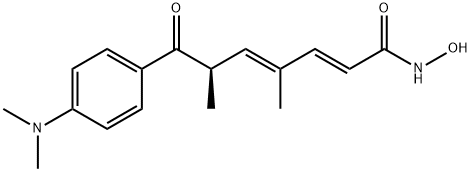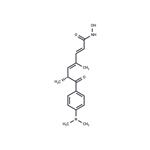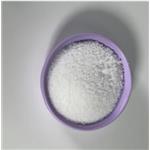Description
Trichostatin A (58880-19-6) is a potent and selective histone deacetylase (HDAC) inhibitor (Ki = 3.4 nM). Induces reversion of ras transformed cells to normal morphology. Trichostatin A induces dedifferentiation of primordial germ cells into embryonic germ cells. Cell permeable and active in vivo.
Chemical Properties
Solid
Uses
Trichostatin A, ready-made solution has been used:
- as a histone deacetylase inhibitor to study its effect on transcriptome changes by stem cell testing
- to inhibit histone deacetylase (HDAC) class I, II, or III in primary pituitary cell cultures and to investigate insulin control of endogenous human growth hormone gene (hGH)
- to treat cells for the HDAC inhibition experiments
Uses
Trichostatin A is a histone deacetylase inhibitor that enhances the cytotoxic efficacy of anticancer drugs that target DNA. Trichostatin A displays antifungal, antiprotozoan and antitumour activity
Uses
Trichostatin A is a known inhibitor of fibrosis in vitro and in vivo, and is used as an anticancer agent. Potent differentiation inducer of friend leukemic cells.
Definition
ChEBI: Trichostatin A is an antibiotic antifungal agent, a trichostatin and a hydroxamic acid. It has a role as a bacterial metabolite, a geroprotector and an EC 3.5.1.98 (histone deacetylase) inhibitor. It is functionally related to a (R)-trichostatic acid.
General Description
Trichostatin A is a compound of primary hydroxamic acid.
Biological Activity
Selective and potent inhibitor of histone deacetylase (K i = 3.4 nM). Active in vivo . Potential anti-cancer agent. Induces accelerated dedifferentiation of primordial germ cells (PGCs) into embryonic germ (EG) cells.
Biochem/physiol Actions
Inhibits histone deacetylase at nanomolar concentrations; resultant histone hyperacetylation leads to chromatin relaxation and modulation of gene expression. May be involved in cell cycle progression of several cell types, inducing cell growth arrest at both G and G/M phases; may induce apoptosis. Enhances the efficacy of anticancer agents that target DNA.
storage
-20°C (desiccate)
References
1) Yoshida et al. (1990), Potent and specific inhibition of mammalian histone deacetylase both in vivo and in vitro by trichostatin A ; J. Biol. Chem., 265 17174
2) Futamura et al. (1995), Trichostatin A inhibits both ras-induced neurite outgrowth of PC12 cells and morphological transformation of NIH3T3 cells; Oncogene, 10 1119
3) Durcova-Hills et al. (2008), Reprogramming Primordial Germ Cells into Pluripotent Stem Cells; PLoS-One, 3 e3531




